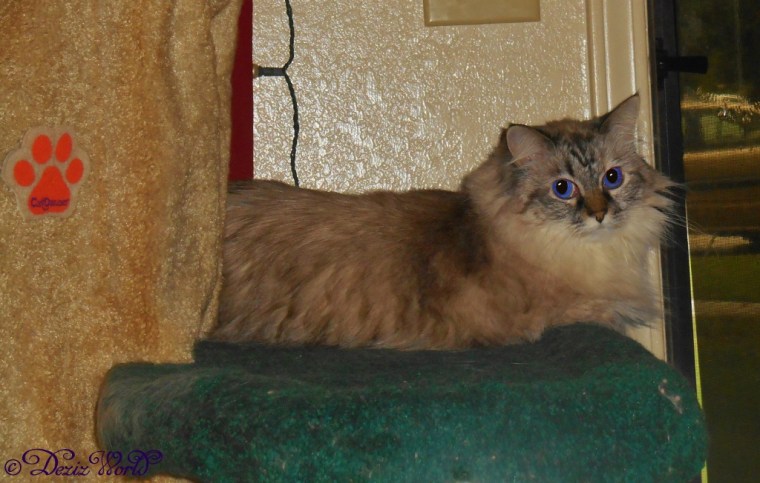Meowllo everypawdy and welcome to another of our educational postys ‘bout Service Cats. As with all our educational postys da remainder will be written in human English. We got a lot of great questions over da last week, so we thought we’d focus on those today. Purrlease keep da questions comin’. Ifin you missed any of our postys you can read them by clicking on da links below.
Service Cats: What to look for
Service Cats: Training Foundation
Service Cats: How to train kitty to Massage without claws
Service Cats: Smelling Disease
First up tho’ we thought you all might enjoy seein’ Raena pawin’ an alert fur mommy. She was a little confused cuz she’s not used to mommy tryin’ to take a foto of her doin’ it, but dat paw there is on it’s way to pat mommy on da face.
See that paw to the right?
Here’s a close up of that right paw about
to reach mommy’s face to start patting
Okay, let’s get on with da questions. The first question comes from our friends over at Eastside Cats. They ask, Can a Service or Therapy Cat be trained by one person and then go to live with another? That’s a great question, and the answer is a bit convoluted. First let’s address the Service Animal part of that question because there is a huge difference between the 2. As you know most seeing eye dogs are trained and then sold to a disabled person in need. Make no mistake, these charges are outrageous. Anyways, this does cause one to ask the above question. On the one hand the answer is Yes. There are tasks kitty could learn to perform that could then be performed for anyone. For instance, a kitty could be trained to drive a wheelchair or alert to a specific smell, answer a phone, open cabinets, etc. and then placed in the home of a disabled person who has need of those things. Such a kitty would most likely be clicker and treat trained so that they are essentially performing a “trick” on command. There would need to be a few days of additional in home training to get kitty accustomed to his/her new handler and performing the trained tasks for them. (We can’t even begin to imagine the cost of such a kitty.) And the new handler would need to spend extra time bonding with kitty once placed.
Now for the convoluted part of that answer. A kitty trained elsewhere and placed with a disabled person may not actually “work” right away. Unlike dogs, cats aren’t fans of change and do take a bit to feel comfortable in their new surroundings and with their new person/people. Kitty is performing tasks, but is doing so much like a doggy performing sit/stay. There is nothing wrong with this method, but mommy prefers a kitty that performs because they want to help as opposed to one expecting a treat or other reward. Mommy prefers a bonded kitty so that kitty can anticipate and learn what mommy needs as her condition changes.
Now let’s get to the Therapy cat part of that question. A Therapy Cat Does Not perform any specific duties or trained tasks to assist a disabled person. No real training is required to be a Therapy Cat. A therapy animal is one that visits hospitals, nursing homes, etc. with their handler to make people feel good. This can be achieved by letting people pet them, hold them, or just be in the room with them. A Therapy Cat and it’s handler Must attend a training session/seminar to learn the rules on how to prepare for entry into these places and what is allowed and not. Therapy cats and other animals must be bathed regularly, must have a calm and sedate temperament, etc.. Since Therapy Cats and their handlers must attend this training together, then No, Therapy cats cannot be trained by a second hand party. Most of the training for a Therapy Cat is for the human handler. The only real training required for the Cat, is that they be calm and allow people to pet and handle them without scratching or biting. Some breeds are better at this than others. For a full definition/description of Service Animals, Therapy Animals and Companion Animals, please click here.
The next question we were asked is: Would mommy train Service Cats for others? The answer is yes, she has trained cats for others in the past and would consider it again in the future. Depending on the required tasks, mommy may have kitty in training live with us temporarily, or she may go to them. As we’ve said many times, mommy prefers the bonded training method over treat training. And generally when one is disabled their condition get worse through the years and not better. A bonded kitty will adapt and almost train themselves to meet your “new” needs.
We were also asked about a specific condition (Neuropathy) and if a Service Cat massaging them would be of any help and if so could they train their current cat. First we need to state that mommy is not a medical doctor and cannot diagnose anyone’s medical condition. We also cannot determine whether a Service Cat would benefit you if we haven’t met and spent time in person with you. That’s a decision only you and possibly your doctor can decide. We have continually said that any and all cats can be trained, so the answer to that part of the question would be Yes. But we do recommend starting from the very beginning and re-bonding with your resident cat before moving to the next step in training.
This person also asked about training their resident dogs to alert for seizures. Again, without meeting everyone in question we can’t give a specific answer. We will say that the dogs may already be alerting and it’s so subtle no one is recognizing it. And then again, they may not be. We’ll say again that you don’t have to have any particular breed of cat or dog. Altho’ some breeds do make better Service Animals than others. A “smashed faced” cat or dog shouldn’t be expected to scent alert. They can, but but they may not be 100% accurate. A Service Animal must perform their trained tasks every time. Be realistic in your expectations of a Service Animal. People don’t train toy dogs to be guard dogs. Why? Because they’re not scary and can’t deter criminal behavior. So don’t expect the animal or breed you’ve chosen to perform duties beyond their physical capabilities.
The Kitties Blue asked about training massage, but we’ve covered the basics of that in the Training Kitty to Massage post (click link above), so we won’t go over it again here. However, we will expand on it in a future post. They also asked if the trainee had to be a kitten. As we’ve said before, No, any cat can learn at any age. We do recommend starting at the beginning with the bonding process before moving forward with training. And yes, even with your resident cat.
Well, we’re gonna wrap it up fur today. We’ve covered a lot of information here so we’ll give ya’ some time to digest it all. We’ll say in closing that Service animals are Not provided to the disabled for free. The charges, as we’ve stated earlier are outrageous. This is one of the reasons mommy believes in home training. Most disabled people we know live on a fixed income and can’t afford thousands of dollars for a Service Animal. Anyways, we hope you enjoy our post. Please leave any questions you have in the comments. We love hearin’ from you and reading your questions.
Do you (Does your kitty) have the temperament to be a Therapy cat?
Are you still confused about the differences between a Service Cat, Therapy Cat and Companion Cat?
What do you think is the average charge for a trained Service Dog?








Sometimes service animals are ‘donated’ to the new disabled person by some philanthropic group such as knights of Columbus, etc.
Our furbear Toki might have been a candidate to be a therapy kitty, he was our resident greet all kitty!
We are not like that at all…
We sure hope this all will change for the better with good education and public knowledge.
LikeLiked by 1 person
Most service animals a provide for by charities in the UK like guide dogs for the blind,and hearing dogs for the deaf and there is normal no charge to the person that receives the animal,may be the should be the way to go in the US and Canada,xx Rachel and Speedy
LikeLiked by 1 person
Meow Speedy and awnty Rachel, dat’s pawsum. It would be great ifin da US did it dat way too, but alas, everypawdy here’s all ’bout da money.
Luv ya’
Dezi and Raena
LikeLiked by 1 person